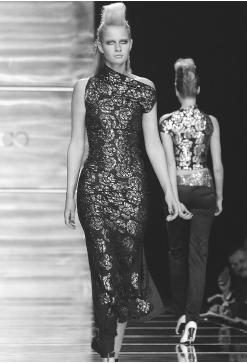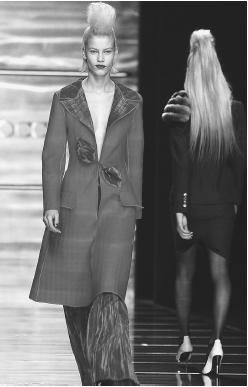Rocco Barocco - Fashion Designer Encyclopedia
Italian designer
Born: Naples, Italy, 26 March 1944; christened Rocco Muscariello. Education: Attended Accademia delle Belle Arti, Rome, 1962 (Fine Arts). Career: Sketch artist, De Barentzen, 1963-65; joined group to form atelier producing high-fashion collections under Barocco label (disbanded 1974); independent designer using Barocco label, from 1977; Rocco Barocco ready-to-wear line added, 1978; knitwear and children's lines introduced 1982; produces ready-to-wear, jeans, knitwear, scarves, leather goods, accessories, perfume, porcelain tiles, and linens. Exhibitions: Italian Fashion in Japan, Daimaru Museum, Osaka, 1983; Italian Fashion Design, Italian-American Museum, San Francisco, and Pacific Design Center, Los Angeles, 1987; La Sala Bianca, Palazzo Pitti, Florence, 1992, and the Louvre Museum, Paris, 1993. Awards: Senior Singer Company award, New York, 1969. Address: Piazza di Spagna 81, 00187 Rome, Italy. Websites: "Rocco Barocco," FirstView Collections Online, spring 2001; "Rocco Barocco," Moda Online, fall 2000/2001; "Rocco Barocco," Quitidiano.net, fall/winter 2001.
Publications
On BAROCCO:
Books
Bottero, A., Nostra Signora la Moda, Milan, 1979.
Giordani Aragno, B., 40 Years of Italian Fashion, Florence, 1983.
Italian Fashion in Japan, Osaka, 1983.
Giacomoni, S., The Italian Look Reflected, Milan, 1984.
McDowell, Colin, Directory of Twentieth Century Fashion, London, 1984.
Bianchino, G., and A. Quintaralle, Fashion—From Fable to Design, Parma, Italy, 1989.
La Sala Bianca, Milan, 1992.
Zito, Adele, Italian Fashion: The Protagonists, Italy, 1993.

Articles
Gargia, Massimo, "Barocco ou l'Amour des Passions Inutiles," in L'Officiel (Paris), September 1979.
Melendez, R., "Best of Italy," in Women's Wear Daily, 26 August 1989.
Lanza, S., "The A. W. Collections from Italy," in the Sunday Times (London), 2 September 1990.
"Italy's Passion for Fashion," in Sunday Morning Post (South China), 1 December 1991.
"La Botte Secrete de la Mode Romaine," in Paris Capitale, May 1994.
"Burani Buys Two Leather Firms," in Women's Wear Daily, 6 November 2000.
*
I started my career very young and so it is natural that I should have a certain leaning towards the avant-garde. My first creations were challenges to the styles of the period and very courageous. Technique and experience combined with my taste for the daring in fashion have led to the birth of a clearly defined style that can be recognized in my often repetitive choice of colors: black, black/white and optical effects.

In [one] collection a floral leitmotif (a rose in particular) appears, inserted into spotted or striped designs (leopards, zebras, tigers). The rigorousness of my cut can be recognized in the jackets and cloaks which in their different inspirations (oriental, African, military) always reveal a search for perfect construction. I have a predilection for soft and sumptuous materials, for embroidery and for gold in particular. If we want to define the Rocco Barocco style we must use words like rigor, humor, audacity, and poetic imagination.
—Rocco Barocco
***
Rocco Barocco, or Rocco Muscariello as he was christened, is an Italian ready-to-wear designer who creates collections for men, women, and children in a variety of ranges from jeans and knitwear to evening wear. Born in Naples in 1944, he moved to Rome in order to follow his chosen career path. After apprenticeship and training at the city's leading ateliers, he eventually opened his own in the Piazza di Spagna in 1968. Success was immediate, and his popularity with the Roman jetset increased his fame throughout Europe. He was soon exporting clothes to France, the U.S., and Japan.
Rocco Barocco defines his style as being rigorous, humorous, impudent, and poetically imaginative. He has a taste for the daring and avant-garde in design and detailing, such as his bright red chiffon evening gowns with bold, asymmetrically draped necklines. He also enjoys working with embroidery and gold, in particular. A distinctive sequin and embroidered jacket from his spring/summer 1993 collection paid joint homage to the stars and stripes of the American flag and the daring circus performers from Elsa Schiaparelli's Circus Collection of the late 1930s. Barocco prefers to work in soft and sumptuous materials like paillettes and satins or cashmeres and crêpes. His favorite color combinations are black, black and white, or optical effects, combinations repeating themselves through numerous collections and which have helped define the Rocco Barocco style.
When he began designing, Barocco's intention was to challenge established silhouettes and shapes with a search for perfection in cut, construction, and symmetry. Examples of his cutting skills are displayed in his jackets and coats. His autumn/winter 1989 collection showed long, swinging, dove gray cashmere coats, perfect in balance and proportion and trimmed in fur. His fitted, shawl-collared jackets and suits hinted at masculine classics but exuded femininity in their curvaceous cut, proportion, and detailing. Barocco represents a unique Mediterranean flavor in contemporary fashion; he enjoys taking strong color and style combinations and mixing them in a diverse manner.
Barocco is also inspired by Hollywood, which he views as a fascinating land of unsettled heroes and heroines and a cornucopia of visual reference for high fashion. Hollywood movie stars and fashion in the movies have always been over the top—this undoubtedly contributes to Barocco's taste for the daring in fashion, exemplified in his newer, notorious swimwear-to-lingerie collection. The Rocco Barocco label is also found on ranges of leather goods, handbags, hosiery, jewelry, umbrellas, and shoes. His perfume and toiletry line, Rocco Barocco III, has had lasting success, and the designer branched out into designs for the home, including furniture, porcelain tiles, and refined ceramics. Barocco views his success as transitory, accompanied by inevitable changes. However, from an outsider's point of view, these changes only result in further expansion of the business, ultimately promoting the name of Rocco Barocco on a wider scale.
Probably best known outside Europe for his jeanswear and perfume lines, Barocco apparel ranges from shimmery fabrics such as silks and satins to houndstooth slacks paired with bright pink and lime green sweaters. In his fall 2000 women's collection, shown in Milan, Barocco reinterpreted styles of the 1950s with a postmodernist slant and a spirit of elegance, according to the website Moda Online. The reviewer compared the silhouettes in his spring/summer 2000 women's line to the creations of the French crystal company Lalique. In fall 2001, Barocco focused on a spiderweb theme, incorporating this design from nature into pants and tops that hugged the body yet remained free flowing.
Barocco's men's collection for fall/winter 2001 was described by Italian reviewers as typically British, a mix of the Rolling Stones and Prince William with a little Jimi Hendrix thrown in. Slacks were paired with long coats and no shirt, accessorized with long scarves, in a rock star-inspired style. The ever expanding Rocco Barocco collection includes licenses for leather goods, produced and distributed by the Italian firm Braccialini, and varied denim designs, manufactured and sold by Swinger International.
—Kevin Almond;
updated by Karen Raugust
Comment about this article, ask questions, or add new information about this topic: